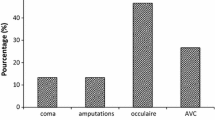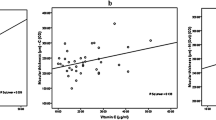Abstract
Lipid peroxides are thought to be formed by free radicals and have been implicated in the pathogenesis of diabetes complications. A convenient and sensitive method for estimation of lipid peroxide concentration is the quantitative estimation of their metabolic end-product malondialdehyde (MDA) expressed in mmol/L using the thiobarbituric acid test (TBA-test). We have measured the serum concentrations of MDA in 60 well controled type I diabetic patients (28 without retinopathy and 32 with retinopathy) and 13 age-matched healthy subjects. Patients with retinopathy showed significantly increased MDA level (2.65±1.00) compared to diabetics without retinopathy (1.80±0.81) and healthy controls (1.47±0.45). The serum levels of MDA correlated best with glycosylated haemoglobin (r=0.28), serum triglyceride concentration (r=0.29) and serum cholesterol concentration. (r=0.47). Increased lipid peroxides suggesting increased free radical activity is associated with retinopathy and this may have pathogenetic implications.
Similar content being viewed by others
References
Wolff SP. The potential role of oxidative stress in diabetes and its complications: novel implications for theory and theraphy. In: Crabbe MJC, ed. Diabetic Complications: Scientific and Clinical Aspects. London: Churchill Livingstone 1987: 167–221
Sacks T, Moldow CF, Craddock PR, Bowers TK, Jacob HS. Oxygen radicals mediate endothelial cell damage by complement-stimulated granulocytes. J Clin Invest 1978; 61: 1161–1167.
Lunec J, Malloran SP, White AC, Dormand TL. Free radical oxidation (peroxidation) in serum and synovial fluid in rhematoid arthritis. J Rheumatol 1981; 8(2): 233–245.
Warso MA, Lands WEM. Lipid peroxidation in relation to prostacyclin and tromboxane physiology and pathophysiology. Br Med Bull 1983: 39(3): 277–280.
Yagi K. A simple flurometric assay for lipoperoxide in blood plasma. Biochem Med 1976; 15: 212–216.
Mallia A, Hermanson GT, Krohn RI. Preparation and use of a boronic acid support for separation and quantification of glycosylated haemoglobins. Anal Lett 1981; 14: 649–661.
Siu GM, Draper HH. Metabolism of malonaldehyde in vivo and in vitro. Lipids 182; 17: 349–355.
Sato Y, Hotta N, Sakamoto N, Matsouka S, Ohishi N, Yagi K. Lipid peroxide level in plasma of diabetic patients. Biochem Med 1987; 21: 104–107.
Abdella N, Awadi F, Salman A, Armstrong D. Thiobarbituric acid test as a measure of lipid peroxidation in arab patients with NIDDM. Diabetes Res 1990; 15: 173–177.
Nishigaki I, Hagihara M, Tsunekawa H, Maseki M, Yagi K. Lipid peroxide levels of serum lipoprotein fractions of diabetics patients. Biochem Med 181; 15: 373–378.
Gallou G, Ruelland A, Legras B, Maugendre D, Allannic H, Cloarec L. Plasma malondialdehyde in type 1 and type 2 diabetic patients. Clinica Chimica Acta 1993; 14: 227–234.
Gutteridge JMC. Superoxide dismutase and free radicals in clinical chemistry. Ann Clin Biochem 1976; 13: 393–398.
Jenning PE, McLaren M, Scott NA, Saniabadi AR, Belch JJF. The relationship of oxidative stress to thrombotic tendency in type I diabetic patients with retinapathy. Diabetic Med 1991; 8: 860–865.
Monnier VM, Vishwanath V, Frank KE, Elmets CA Dauchot P, Kohn RR. Relation between complications of type I diabetes mellitus and collagen-linked fluorescence. N Engl J Med 1986; 314: 403–408.
Altomare E, Vendemiale G, Chicco D, Proacacci V, Cirelli F. Increased lipid peroxidation in type 2 poorly controlled diabetic patients. Diabete & Metabolisme 1992; 18: 264–271.
Stringer MD, Görog PG, Freeman A, Kakkar W. Lipid peroxides and atherosclerosis. Br Med J 1989; 298: 282–284.
Katoh K. Possible relevance of lipid peroxidation and thromboxane production to the initiation and or evolution of microangiopathy and non-hyperlipidemic type 2 diabetes mellitus. Diabetes Research and Clinical Practice. 1992; 18: 89–98.
Arshad MAQ, Mooradian MD. Increased serum conjugated dienes in elderly diabetics patients. J Am Geriatrics Society. 1991; 39: 575–580.
Baynes JW. Role of oxidative stress in development of complications in diabetes. Diabetes. 1991; 40: 405–412.
Author information
Authors and Affiliations
Rights and permissions
About this article
Cite this article
Losada, M., Alio, J.L. Malondialdehyde serum concentration in type 1 diabetic with and without retinopaty. Doc Ophthalmol 93, 223–229 (1997). https://doi.org/10.1007/BF02569062
Accepted:
Issue Date:
DOI: https://doi.org/10.1007/BF02569062




